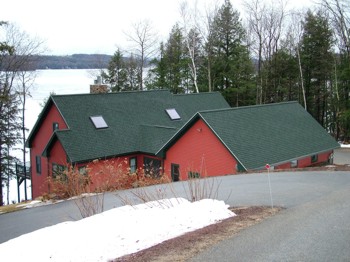Roof Shingles
DEAR TIM: Roof shingles ended up in my yard after a storm. An inspection showed it’s time for new roofing shingles on my home. I’m perplexed as to what roof shingle to select after going to a recent home show. There are so many types and styles I’m having trouble picking my new shingle roofing. Aside from the shingles themselves, what else should I be concerned about to ensure my roof is leak-free in the future? Amber B., Landsdale, PA
DEAR AMBER: Asphalt roof shingles have to be the most common roofing material for residential homes, and I suspect you saw many at the show. Because they are relatively inexpensive to manufacture and install, asphalt roofing shingles are the weapon of choice most builders, remodelers and homeowners select when they want to battle Mother Nature.

These architectural roof shingles have a very long warranty. PHOTO CREDIT: Tim Carter
I’ve seen other homeowners stress about making color and texture selections for their asphalt-shingle roof. It makes sense, as the roof can sometimes be the most prominent feature of the home when you first see it. That’s the issue I have with my current home in New Hampshire. You drive down to the house from the road, and all you see is roof as you approach the house.
If your roof has a low slope, and you really can’t see the roof from the ground too well, try to relax. The best way to make a selection is to try to narrow your choice to just two or three shingles. Consider buying just one bundle of each, and have a handy man lay out the shingles over one another just as they would be nailed on your existing roof creating a square that measures about 6 feet by 6 feet. Stand at the street and look at each patch trying to imagine what the entire roof would look like. This experiment might only cost you $150 to do, and it only takes a couple of hours from start to finish. This beats looking at a small sample on a board sitting at your couch.
Shingle roofs, as you pointed out, come in several different species. Solar roof shingles are in the limelight now as we try to make better use of the sun’s free energy. If you start to consider this alternative, be sure to do the math. It could take many years before you break even on your investment. Metal roof shingles are also made that resemble both wood shakes and traditional asphalt shingles. When metal roofing shingles are installed correctly, they’ll very likely be the last roof you’ll pay for. A metal shingle roof can last generations.
Architectural roof shingles are something you should be looking at for sure. Manufacturers laminate two or more layers of different shapes of asphalt roofing to create depth in the shingle so it has a very handsome appearance. You can also get regular asphalt shingles that are oversized and have a shadow line built into them. These simulate the look of a slate roof. I have these on my garden shed, and will be installing them on my entire house this summer. From the street, these shingles do look like traditional slate.
Installing roof shingles may seem like a simple task, but there are some very mission-critical steps that need to be followed. I highly recommend you decide on the shingle you want, and then get from the manufacturer their written roof-shingle installation instructions. Every manufacturer prints these, and they are easy to obtain online or even on the wrapper of the shingles. It would be in your best interest to read these instructions so you can interview roofers to see which ones know exactly how to install your new roof.
When you install roofing shingles, you need to be concerned about the position, type and length of the nails that are being used. Pay attention to the requirement for underlayment. Since you live in a snowy area, you should really consider installing an ice-dam membrane along the edges of your roof, in valleys, at pitch changes, around skylights, etc. Traditional roofing felt or modern underlayments are always a great idea, and they may be called for in the written instructions as a warranty requirement. Almost always an underlayment is part of the fire classification of roof shingles.
Asphalt shingle roofing is a huge business, and it attracts all sorts of people both good and bad. Each year, I get hundreds of desperate emails from homeowners whose roof shingle installation has turned into a disaster. When the autopsy results are complete, the leaks can almost always be traced to poor workmanship at flashings.
Flashings are transitional roofing materials that connect the roof to things that aren’t the roof. For example, you have flashings at skylights, plumbing vent pipes, chimneys, valleys, dormers, exhaust ducts, turbine vents, etc. In other words, any place where a shingle touches up against something that’s not a shingle, you almost always need a flashing.
Books have been written about installing the many different types of flashings. Suffice it to say that you want a seasoned roofer that knows what tin, copper, soldering irons, and stick solder are. If you ask roofers who are bidding your job about these materials, and they chuckle pointing to their trusty caulk gun, you want to keep interviewing until you discover a roofer or two that can solder a vertical line that looks like a gorgeous line of knitted yarn.
Column 772